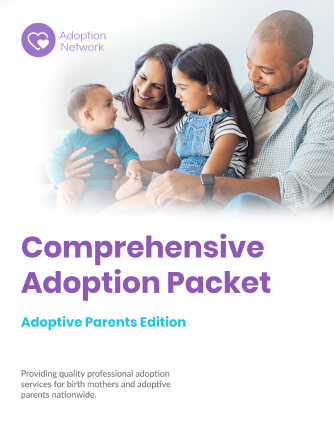
Same-Sex Adoption
In the past, same-sex couples faced many legal obstacles when trying to adopt. However, with the advent of same-sex adoption’s legalization in all 50 states, while same-sex couples seeking to adopt still face some roadblocks and barriers to adopting, there has been a marked increase in same-sex individuals and couples turning to adoption to create or expand their families. So whether you are a prospective same-sex couple or LGBTQ individual looking to adopt we hope you find this article helpful.
Facts and Figures: Same-Sex Adoption Statistics
- As of 2016, LGBTQ adoption was effectively made legal in all 50 U.S. states.
- Today, LGBTQ individuals are coming out earlier in life and an increasing number of same-sex couples are planning and creating their families through assisted reproductive technology (ART) and surrogacy, as well as adoption and foster care.
- As of this last decade, an estimated 6 to 14 million children have a gay or lesbian parent. And, between 8 and 10 million children are being raised in gay and lesbian households.
- The states with the top percentages of gay and lesbian parents are: Washington, D.C., Massachusetts, California, New Mexico and Alaska, with the state of California having the highest number of adopted children living with same sex parents.
- LGBTQ couples are four times more likely to have an adopted child than their counterpart different-sex couples.
- According to a press release by UCLA’s Williams Institute, same-sex couples that adopt children are more diverse in socioeconomic status and ethnicity, contrary to popular misconceptions that they are predominantly white, urban and wealthy.
- According to a Review of Research Prepared for American Sociological Association Amicus Brief, in the United States, studies reveal that children raised in same-sex parent families fare just as well as children raised in different-sex parent families across a wide spectrum of child well-being measures including: academic performance, cognitive development, social development, psychological health, early sexual activity and substance abuse.
- According to a 2014 Gallup poll, a majority of Americans say same-sex couples should have the legal right to adopt a child. Young people between the ages of 18 and 29 are most likely to support the idea, with 77% saying same-sex couples should be allowed to adopt. Support for same-sex adoption declines with each successive age group, but even among those aged 65 and older, a slim majority, 52%, believe same-sex couples should be legally permitted to adopt. Americans’ support for adoption by same-sex couples is higher than their support for same-sex marriage.
- There are measures in some states that allow state as well as private-funded agencies to refuse to place children with unmarried or gay prospective parents.
Frequently Asked Questions (FAQ) About Gay and Lesbian Adoption

In a private US adoption, how is LGBTQ adoption different from heterosexual adoption?
In a private US adoption, the process for LGBTQ individuals or couples is generally no different than for heterosexual individuals or couples looking to adopt, as everyone still has to find an adoption professional to guide them, complete a home study, and then wait for a Birth Mother to select them.
The main difference however, is that due to adoption agency preferences, some agencies may choose not to work with LGBTQ individuals or couples.
If you are a same-sex couple or an LGBTQ individual, make sure you do your research on an adoption entity’s preferences to see if you would be qualified to work with them. Read our article on “Choosing an Adoption Agency/Professional” for more information.
In US foster care adoption, how is LGBTQ adoption different from heterosexual adoption?
For US foster care adoption, although eligibility requirements vary between states and territories, in most instancessexual orientation, as well as marital status, age and income will not automatically disqualify someone from being a foster parent or adopting a child from foster care.
In fact, it has been reported that same-sex couples are six times more likely than heterosexual couples to be raising foster children.
If you are interested in foster care adoption, contact an agency who is authorized to make foster adoption placements and learn about the children in foster care who are waiting for a forever home.
In international or intercountry adoption, how is LGBTQ adoption different from heterosexual adoption?
For LGBTQ individuals and couples, pursuing an international or intercountry adoption may be more challenging than pursuing a foster care or a private adoption in the US based on their sexual orientation.
In an international adoption, all US citizens, same-sex as well as heterosexual, must comply with the laws and regulations governing adoption and immigration both in the United States as well as in the child’s country of origin.
However, while US federal law does not prohibit LGBTQ citizens or same-sex couples from being Adoptive Parents,some foreign countries do not permit LGBTQ individuals or same-sex couples to adopt.
If you are an LGBTQ individual or same-sex couple interested in pursuing an intercountry adoption, you will need to do your research and contact an international adoption agency to see what countries you may be eligible to adopt from.
We talked about it… and we want to adopt. What should my partner or myself expect from a home study?
While the requirements for home studies will vary from state to state in a US adoption and from country to country in an international adoption, the goal of every home study is to educate and prepare the prospective Adoptive family for an adoption, evaluate the capability and suitability of the hopeful Adoptive family and if applicable, gather information about the prospective Adoptive family that will help a social worker match the family with a child whose needs they can best meet.
While there is no single format of home studies, many will include: an orientation, adoption training, interviews, home visits to ensure a safe environment, health statements to verify physical and mental ability to parent a child or children, income and health coverage statements, background checks for criminal and child abuse records, autobiographical statements and references.
The home study process that same-sex individuals/couples go through is generally the same as that of heterosexual individuals/couples. If you have additional questions, we have provided a comprehensive guide to answer all of your home study related questions.
Are the wait times for LGBTQ adoption longer than heterosexual adoption?
In any adoption, adoption wait times for both LGBTQ and for heterosexual adoption varies for a multitude of reasons which may not be tied to sexual orientation.
For example, in a private US adoption, when Birth Mothers are selecting Adoptive Parents, some are specific in the qualities they would like for the Adoptive Parents to have, which may or may not include same-sex families. Some Birth Mothers just want to know that the Adoptive Parents are home-study approved, regardless of whether or not they are same-sex families. In a private US adoption, it is also important to know that the Adopting Parents’ adoption preferences, whether an LGBTQ or heterosexual individual or couple may also influence wait times. Hopeful Adoptive Parents who are more open to situations such as: level of contact with the Birth Mother during the pregnancy and after the birth, ethnicity and gender of the baby and a Birth Mother’s medical history and substance use will mean that more Birth Mother’s will receive their profiles, which may potentially result in a shorter wait time.
For foster care adoption, the time frame to adopt varies with the type of child or children being adopted as opposed to whether or not the family looking to adopt identifies as LGBTQ or heterosexual. For example, the process to adopt a child with special needs, which may include a sibling group, often proceeds quickly and may be completed in months while the wait for a healthy infant can be between two and seven years.
For international adoptions, wait times will vary from country to country. According to statistics, it generally takes from 1 to 5 years to complete an intercountry adoption. For LGBTQ individuals and couples looking to adopt internationally, they must make sure the child’s country of origin will allow for a placement to an LGBTQ individual or couple. An international adoption agency will be able to provide more specific wait times per country.
LGBTQ Adoption Preparedness Checklist: Am I Ready to Become a Parent?
LGBTQ as well as heterosexual individuals and couples must all consider whether or not they are prepared to parent before embarking on their adoption journeys.
- Have I/we come to this decision on our own?
- It is important to minimize the affects that outside sources are having on your decision to parent and adopt. Regardless of what society, your friends and family, or anyone else says, everyone should carefully consider whether or not parenting and adoption is right for them.
- It is not uncommon for two partners to have different thoughts on parenting and adoption. It is critical that both partners communicate and come to a unified decision.
- Am I financially able to support a child?
- The cost of raising a child varies from region to region but raising children is expensive. It is important that a prospective parent is aware of the cost of raising a child before embarking on parenthood. You can use this calculator to determine the costs of raising a child based on your income and where you live.
- Do I have the time and energy to devote to a child?
- Money is not the only resource that a prospective parent should take stock of before deciding on adoption, as it is even more important that one has the time and energy to devote to that child. Before welcoming a child into your home, understand that you may need to adjust your work and social schedule in order to prioritize being a parent.
- If I have a partner, do we have a stable relationship?
- Young children are heavily influenced by their environments so it is crucial that the relationships that are shaping them are both healthy and affirming. No relationship is perfect but having a child will not fix problems that are already present so before you decide to bring a child into your life it is vital that you make sure your proverbial ‘house’ is in order.
- Adopting a child comes with its advantages and its challenges. As a parent, you need to make sure that you and your partner are internally ready to raise a child. Communication during the pre-adoption phase is key. Always check in with your partner to see how they are feeling throughout each stage of the process.
Making the decision to adopt will be a life changing decision for any family, regardless of whether they are heterosexual, gay or lesbian. It is important to make sure you do your research and evaluate the different types of adoption that are available to make sure that you choose the route that is best for your family.
Available 24/7 to Answer Your Adoption Questions


Search Adoption Network
Speak with a Specialist 1-800-367-2367